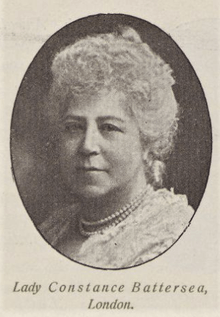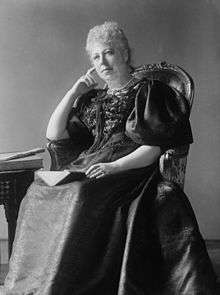Constance Flower
Constance Flower, Baroness Battersea (29 April 1843, Piccadilly, London – 22 November 1931, Overstrand; née de Rothschild), also known as Lady Battersea, was a society hostess and philanthropist in London who established the Jewish Association for the Protection of Girls, Women and Children (now subsumed by Jewish Care) in 1885 and was prominent in the Temperance movement in the United Kingdom.[1][2]
Constance Flower, Baroness Battersea | |
|---|---|
 Constance Flower, Lady Battersea c.1904 | |
| Born | Constance de Rothschild April 29, 1843 Piccadilly, London |
| Died | November 22, 1931 |
| Resting place | Willesden Jewish Cemetery |
| Nationality | British |
| Occupation | Women's rights activist |
| Spouse(s) | Cyril Flower, 1st Baron Battersea |
| Children | None |
| Parent(s) | Sir Anthony de Rothschild, 1st Baronet Louise Montefiore |
| Family | Rothschild family |
Biography
Family
Constance Flower was the elder daughter of Sir Anthony and Lady Louise de Rothschild. She had a younger sister, Annie Henrietta (1844–1926), who married the Hon. Elliot Constantine Yorke (1843–1878), son of Charles Yorke, 4th Earl of Hardwicke.[1]
Early life
She grew up in Paris and moved back to London in 1847. In 1851, her father acquired a country estate in Aston Clinton where she lived with her family[1] Along with the sister Anne, she taught to the poor in the Jews' Free Schools around Aston Clinton, and wrote the book The History and Literature of the Israelites. While she was from a Jewish family, her social background was very Christian.[2]
In 1877, she married Cyril Flower (1843–1907), a property developer and Liberal Party politician who later became Lord Battersea. They had met in 1864 through his friendship with her cousin, Leopold de Rothschild.[3] They had no children.
In 1888, Lord and Lady Battersea acquired two cottages at Overstrand, a village near Cromer, Norfolk, for the purpose of creating a holiday home. In 1897 their architect, Edwin Lutyens, rebuilt and joined the cottages to form a large mansion in extensive gardens, The Pleasaunce. The gardens were developed between 1902 and 1930 by Lord Battersea and his wife. Lord Battersea died in 1907.[4]
Women's rights activism

Lady Battersea was engaged in temperance movement in the United Kingdom, taking the pledge in 1894, and joined the British Women's Temperance Association.[1] Her political engagement was in part motivated by suffragette Fanny Morgan, and propelled her into the reform movement of women's prisons in England. After scandals of child prostitution committed by East European Jews hit the UK press, she co-founded the Jewish Association for the Protection of Girls and Women (JAPGW)[1][2] in 1885 as the Ladies' Association for Prevention and Rescue Work[5], a distinctively Jewish association to shelter and support Jewish immigrants. The JAPGW turned Jewish women immigrant into British feminists, setting the groundwork for the future Union of Jewish Women. The JAPGW also set up the Industrial Training School which trained women to become domestic servants, matrons and home managers. She led the JAPGW until the early 1920s, participating in international meetings and coordinating international rescue operations.[1][2]
Lady Battersea also turned her London apartment and Overstrand compound into shelters for unmarried mothers and women rescued from the prostitution.[5]
Her close ties with the International Council of Women helped her fight off the reluctance of the Jewish higher society to admit that a Jewish prostitution problem existed. After joining the executive committee of the National Union of Women Workers, she became the union's vice-president in 1896, and its President from 1901 to 1903. She remained in the executive committee until 1919, and was made Honorary President of the union after that date. Through her work, she was instrumental in the emergence of conscious Anglo-Jewish feminism.[2]
Lord and Lady Battersea were noted for their philanthropy towards working-class people. She was appointed by the Government to the board of Aylesbury Women's Prison.[6]
Death and legacy
Lady Battersea died in The Pleasaunce on 22 November 1931 on the anniversary of her marriage[1] and was buried at the Willesden Jewish Cemetery.[2] Afterwards, The Pleasaunce was split into separate lots and sold.[4]
The National Portrait Gallery, London holds several portraits of her in its collection.[7]
Publications
- Battersea, Constance (1922). Reminiscences. Macmillan and co. ASIN B002WTRC9E.
References
- "Constance (Connie) de Rothschild (1843–1931)". Rothschild Archive. Archived from the original on 5 November 2019. Retrieved 4 November 2019.
- Gordon Kuzmack, Linda. "Constance Rothschild Lady Battersea". Jewish Women's Archive. Retrieved 24 March 2020.
- Taylor, Catherine. "Family letters: 'a brilliant affair'". Waddesdon. Retrieved 5 November 2019.
- "The Pleasaunce, Overstrand". Historic England.
- Gordon, Peter; Doughan, David (31 March 2001). Dictionary of British Women's Organisations, 1825-1960. Psychology Press. ISBN 9780713040456.
- Cunliffe-Owen, Marguerite (psed)) (4 December 1907). "Letter of the Marquise de Fontenoy'". Chicago Tribune. Retrieved 7 November 2019.
- "Constance Flower (née de Rothschild), Lady Battersea". National Portrait Gallery, London. Retrieved 5 November 2019.